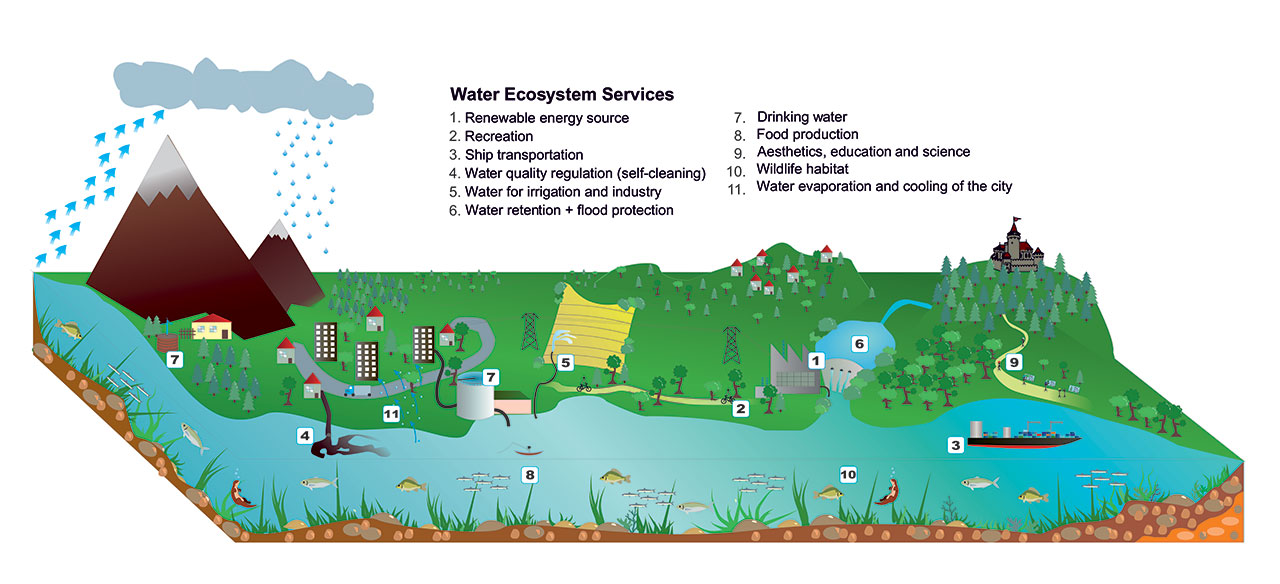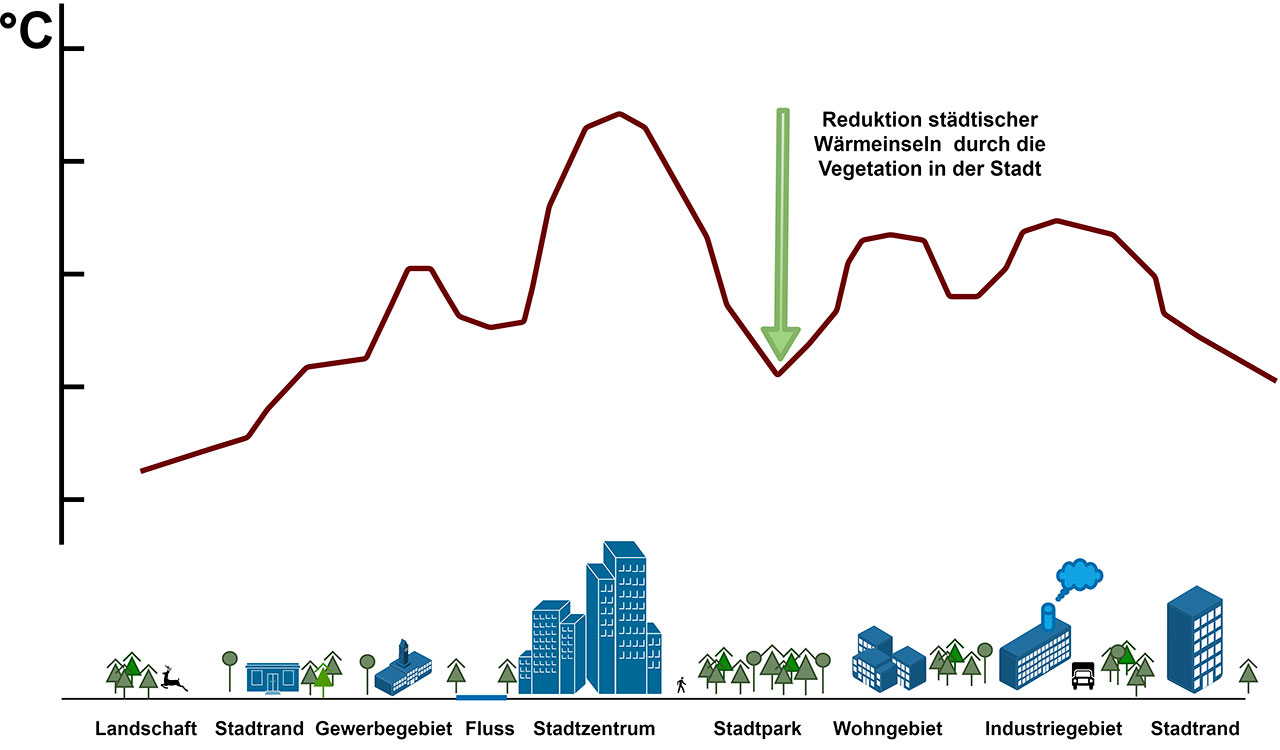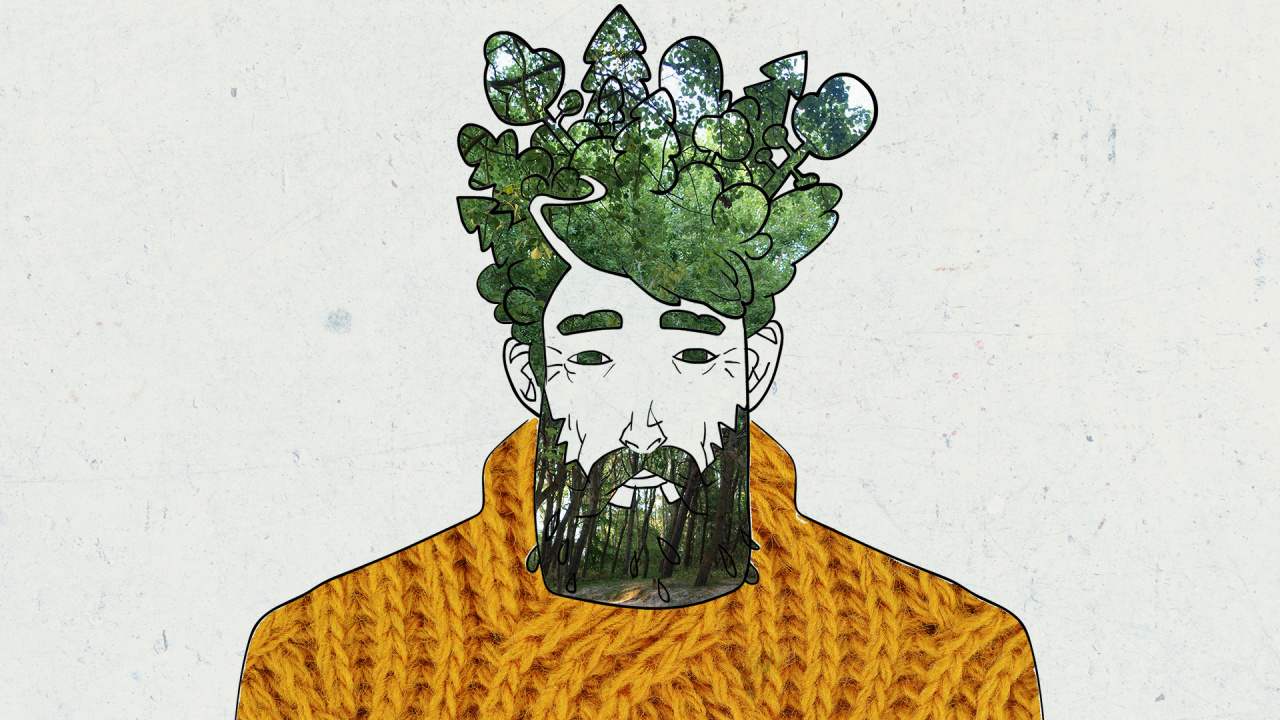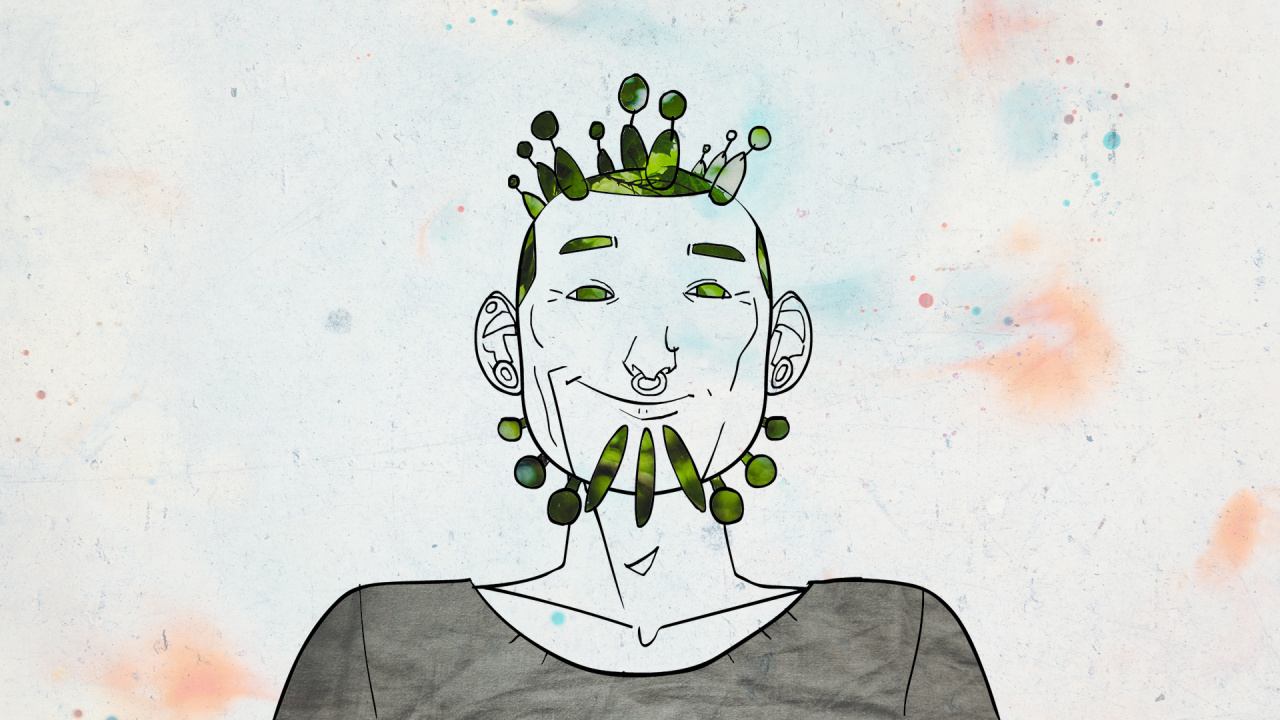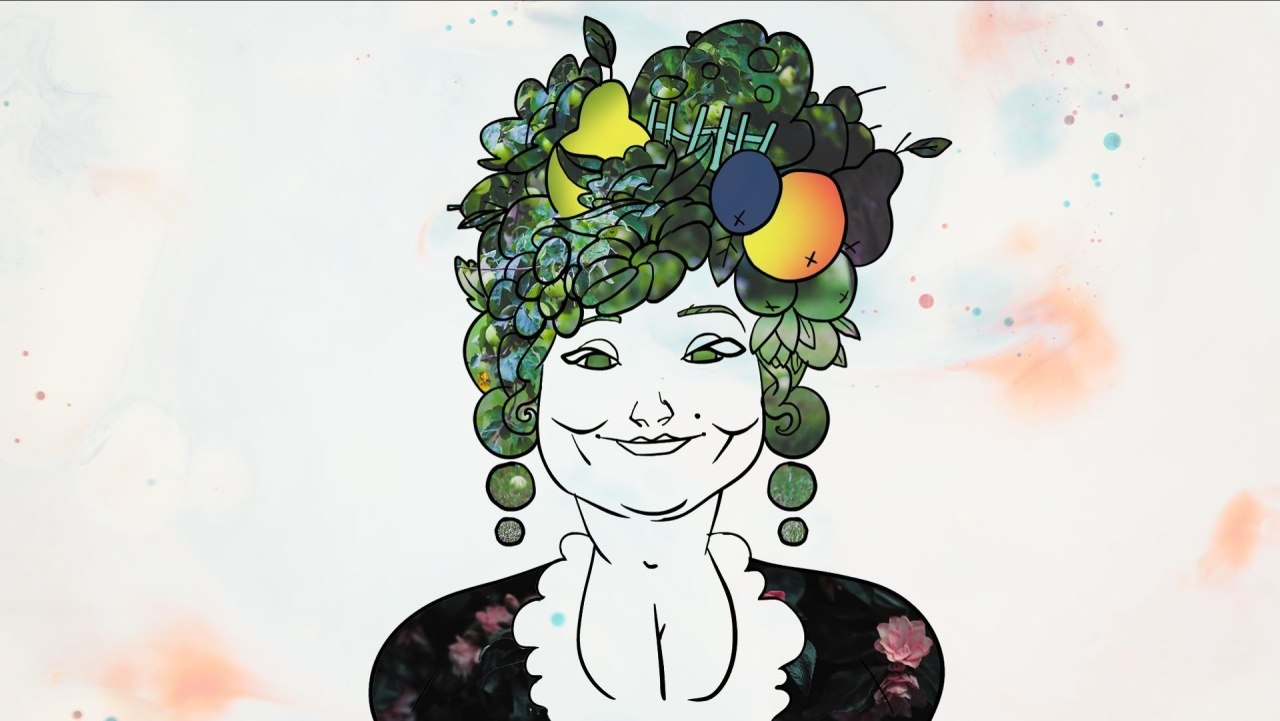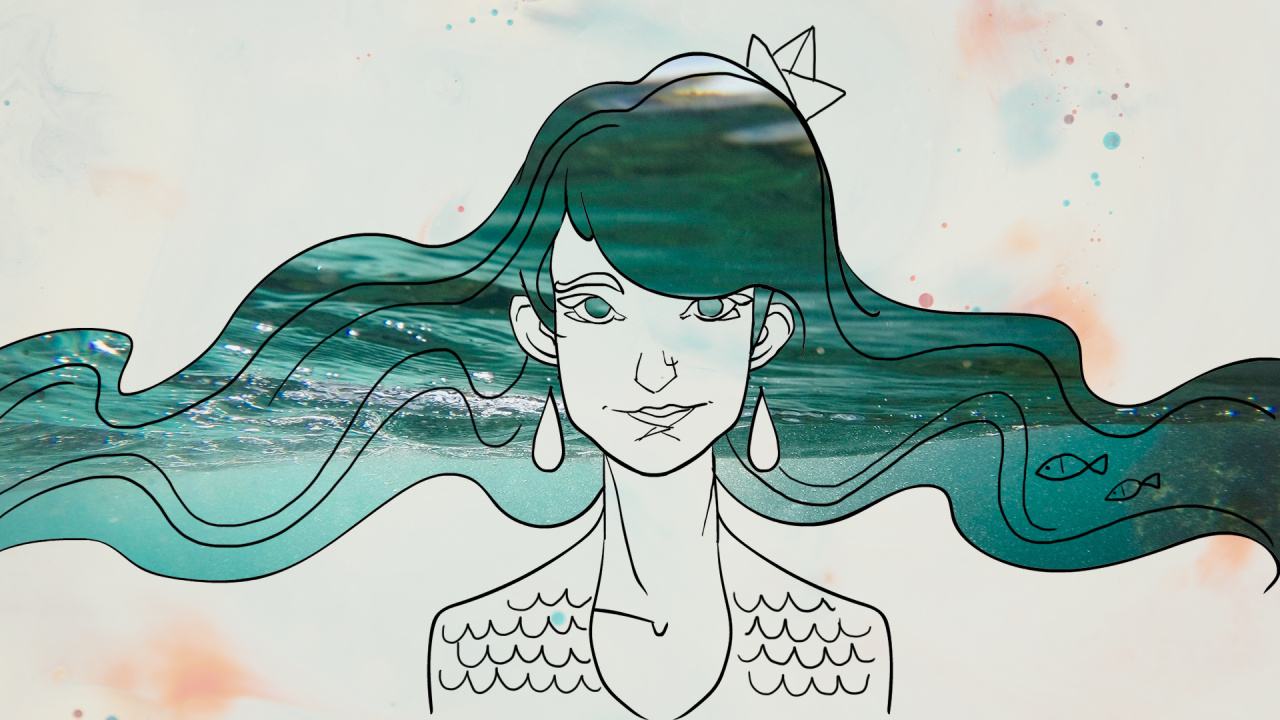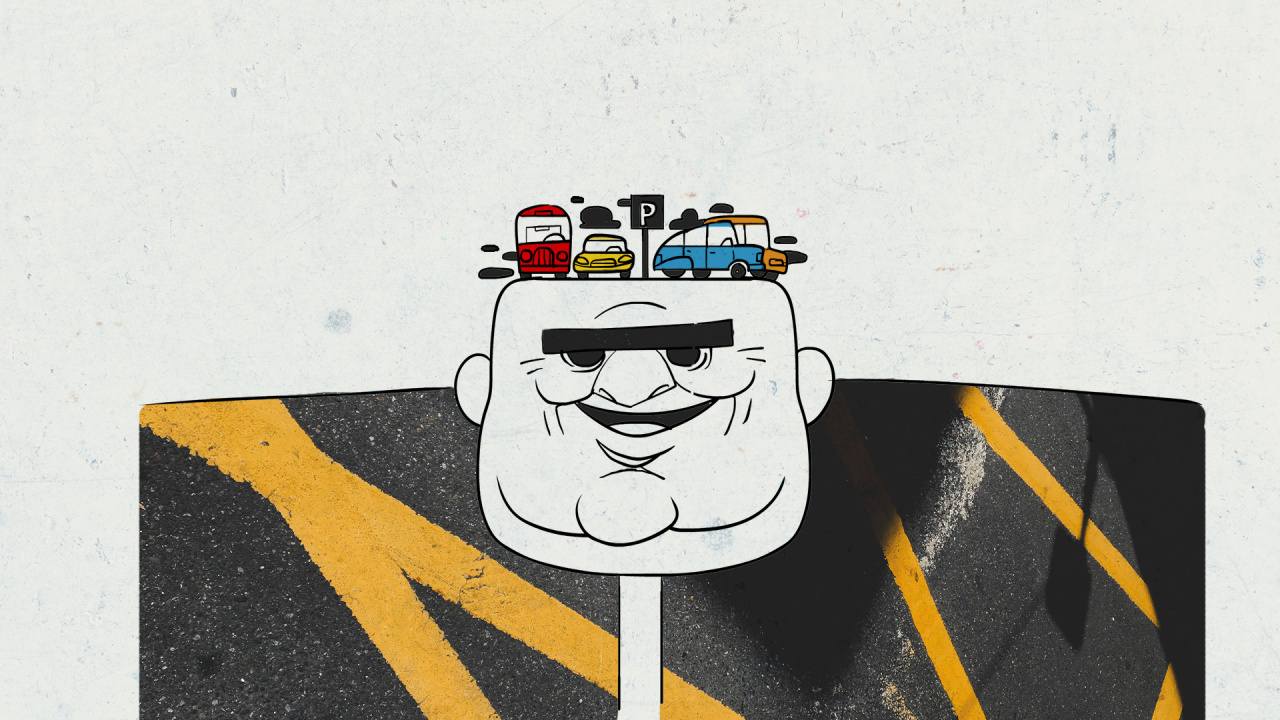BĚŽECKÉ TRASY
Sample Data-Articles
Ecosystem services
Ecosystem services represent the benefits and benefits provided by ecosystems such as water, food, wood, soil formation, air and water purification, flood and drought protection, crop pollination, and more. However, human activity destroys biodiversity and reduces the resilience and ability of healthy ecosystems to deliver this wide range of goods and services.
Biodiversity is the diversity of all life forms and their interaction on Earth. It includes ecosystems, habitats, species of plants, animals, microorganisms and gene variability and their interrelationships. Biodiversity is the foundation of all human life and activity. The products and services that biodiversity provides through healthy ecosystems are vital for sustaining well-being and for future economic and social development.
The quality of life and the future of our cities depend on reconciling modern urban housing, the growing demands of the population on infrastructure and attractive work and leisure opportunities with biodiversity protection. Preserving biodiversity and the ability of ecosystems to provide services is one of the greatest challenges facing humanity at present.
Cooling, flood protection, recreation space and other benefits are services that nature provides for free. They are called ecosystem services. Ecosystem services are called the benefits of nature and are used by man. On the one hand, they are perceived and used directly, such as the environment for recreation and leisure (in the case of parks, gardens) and on the other, indirectly, such as the absorption of air pollutants from the foliage of trees and thereby improving air quality.
The picture 'Ecosystem services provided by water features' shows the wide range of benefits that can be brought to inhabitants in the city by river and other water features.
Ecosystem services provided by water features
Source: IEEP UJEP, graphics: AVIgrafik, s.r.o.
The quality and quantity of ecosystem services provided depends not only on the size of the individual green and water areas, but also on their condition and interconnectivity. That is why we often talk about the so-called green and blue infrastructure - a complex system of interconnected elements of urban natural areas.
The importance of greenery and water features for the quality of life in cities
The important role of natural elements in cities is increasingly evident with the increasing intensity of climate change, such as periods oh hot weather, droughts or brief but intense torrential rains with subsequent floods.
For example, greenery can reduce flooding after torrential rains because it is able to hold and accumulate large amounts of water. Trees, parks and rivers can also act as cooling elements during the hot periods of weather.
In cities, where the effect of the so-called heat island of the city is manifested, trees, shrubs and other vegetation function as natural air conditioners. The thermal island of the city is manifested by the difference between the temperatures in the built-up city center and its “green” edge of several degrees Celsius (see picture “Thermal island of the city”: The temperature curve on the city outskirts and above the park decreases considerably). The elevated temperatures in city centers have significant impacts on, among other things, the health of the population.
Thermal island of the city
Source: IEEP UJEP
Ecosystem services - the benefits that urban nature brings to people
Society is often unaware of the value of the benefits provided by urban nature and their benefits are often underestimated when deciding on land development. One reason for this may be that ecosystem services are often "invisible" benefits and their value can only be calculated in a relatively complex way, compared to the services of a lawyer or hairdresser, which are provided at specific prices.
Urban nature (greenery and water features) brings a variety of benefits to urban residents, workers and visitors alike, thus contributing to improving the quality of life in cities. These contributions of nature, respectively. The individual ecosystems of human society are referred to as ecosystem services. Based on this concept, the services that nature brings are divided into four basic categories (see figure “Ecosystem services scheme”).
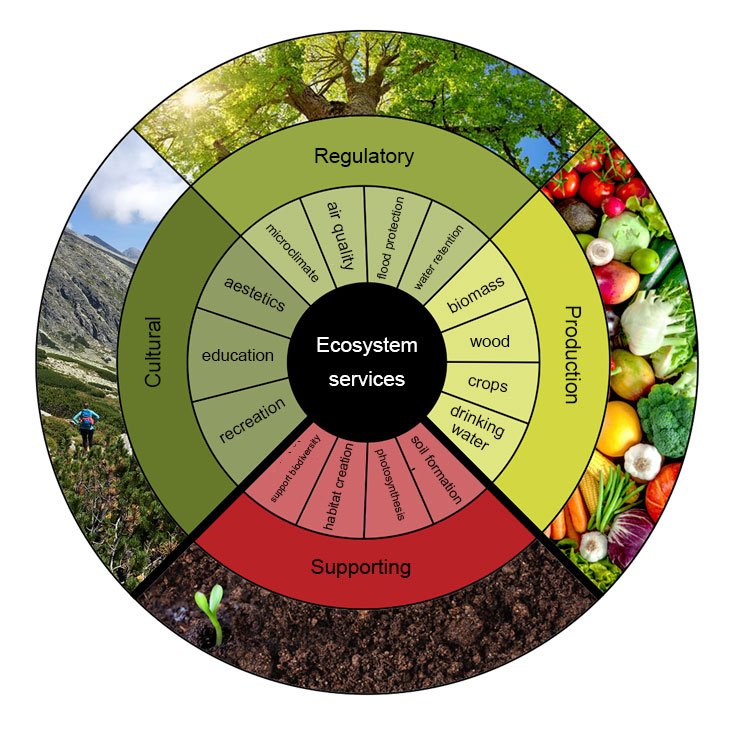
Ecosystem services scheme
Source: IEEP UJEP
Support services represent the basic functions of ecosystems such as soil formation, photosynthesis or habitat formation. Because they are a cornerstone for the functioning of ecosystems and all other categories of services depend on them, these services do not enter into the very evaluation of nature's benefits.
Production services can be easily imagined by any of us. Nature provides us with fruits and vegetables, mushrooms, wood, various fibers, drinking water, etc. These services are mostly marketed in the form of various products, so there is no problem in determining their exact value.
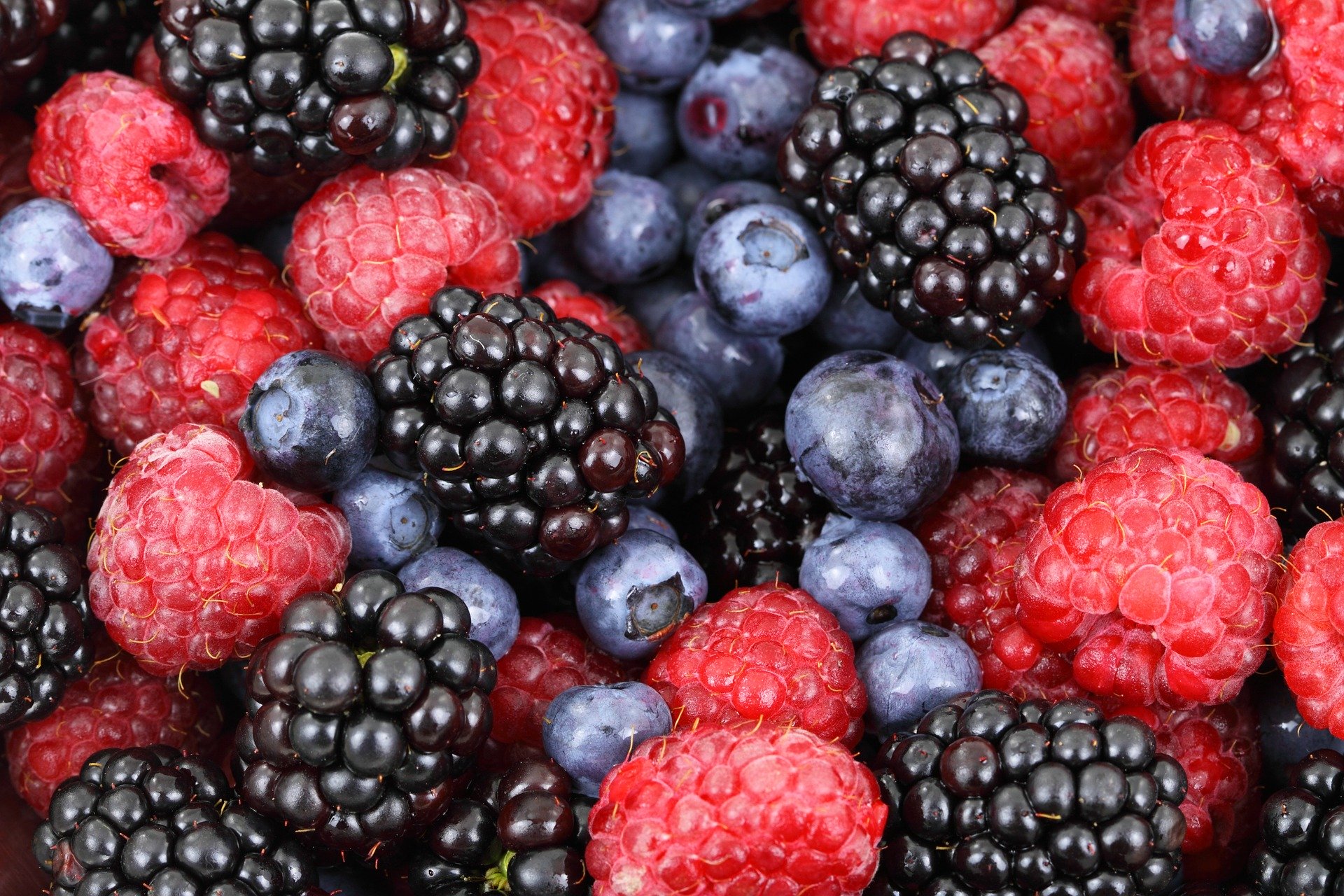
Regulatory services provide society with protection against negative environmental impacts (although these impacts may be caused by human-induced changes in nature). Greenery in the city helps to regulate air quality (catches eg dust particles), regulates the amount and quality of water (catches water in the landscape, helping to protect against floods and drought), reduces soil erosion or cools its surroundings due to water vapor etc. The complex expression of the economic value of these services is often forgotten in land-use planning processes that urban nature also brings these important benefits to society.
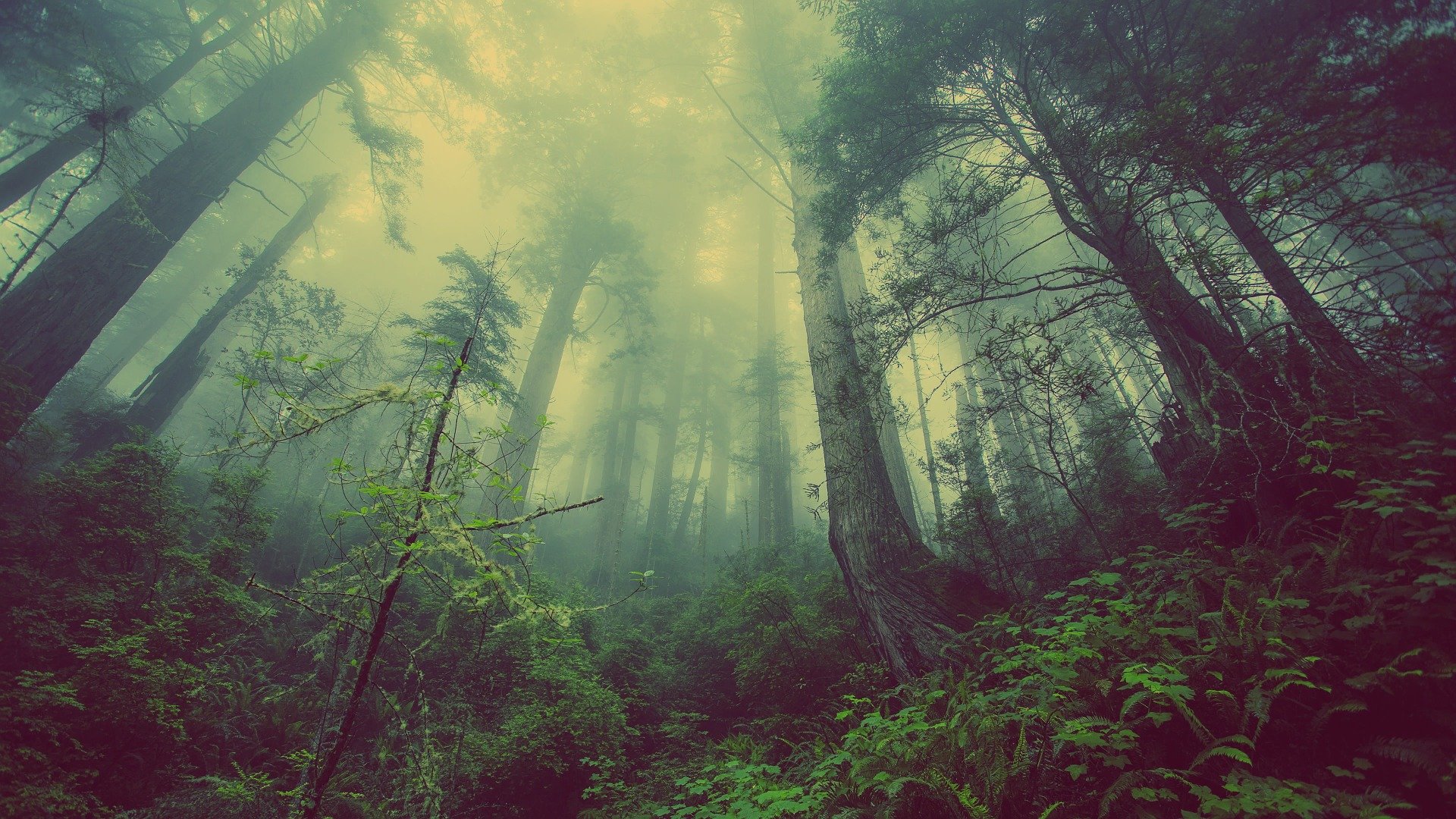
Perhaps the most perceived services of urban ecosystems are the so-called cultural services. Parks, suburban forests, waterfronts and community gardens provide many recreational benefits (space for relaxation, sport activities, short and long-term recreation), aesthetic values (e.g. in the form of inspiration for works of art) or spiritual and religious values (space) for meditation and meditation, sacred places for different religions, etc.). Expressing the value of these services in monetary units is usually the most difficult, but that does not mean that they have no value to the company.
The resources spent on outdoor recreation (whether it is a holiday or a day trip) indicate that people value nature and are willing to pay often considerable sums to admire or regenerate natural beauty (e.g. the well-known Croatian Plitvice Lakes visit annually) about 1.5 million tourists, despite high admission).
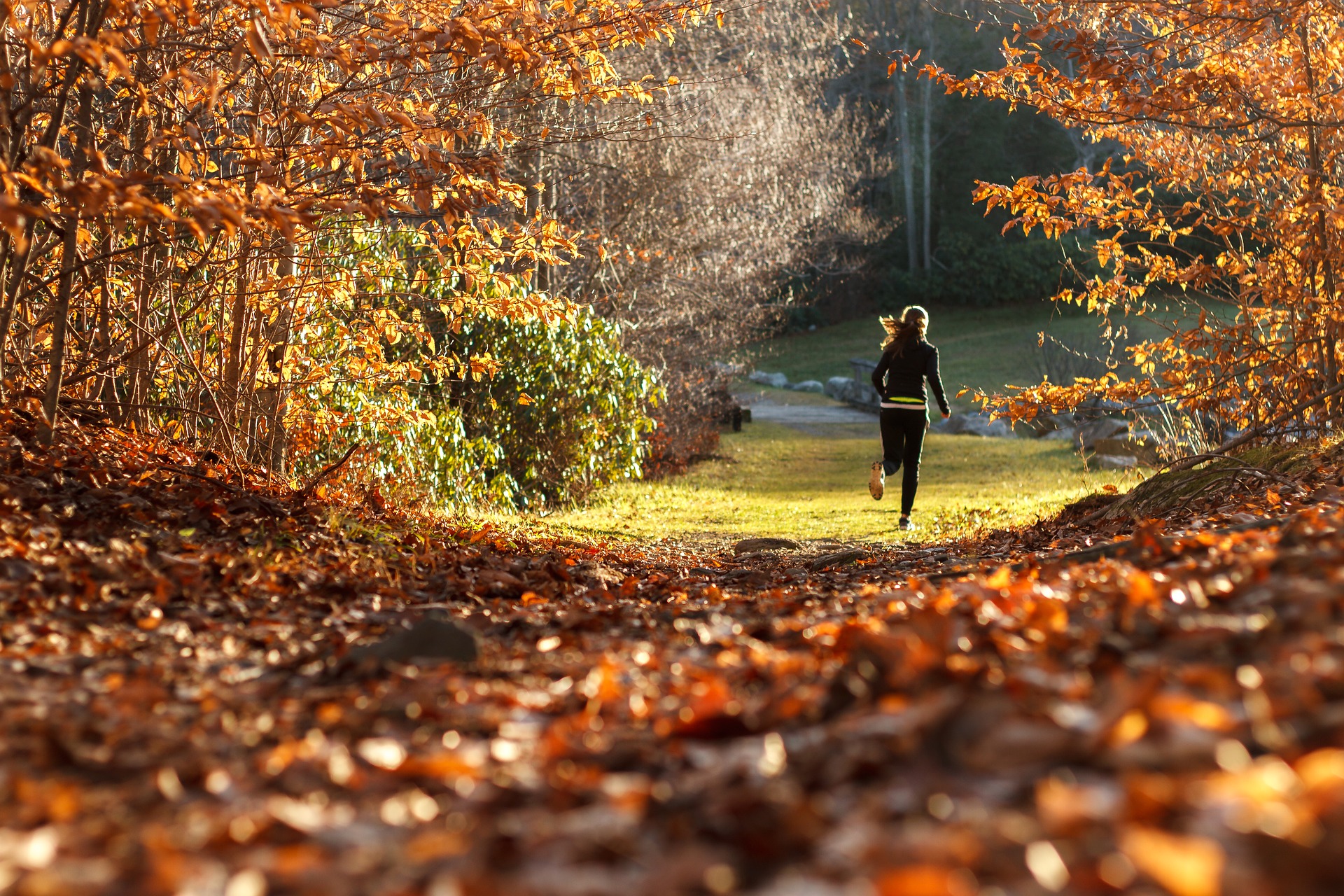
Urban greenery, water features, and their multifaceted functions and benefits
All the greenery and water features in the city bring a whole range of benefits to society in the form of ecosystem services. From food production, water retention or greenhouse gas collection to providing recreation and relaxation.
“Ecosystem services provided by trees in cities” shows the wide range of benefits that trees bring to people in the city.
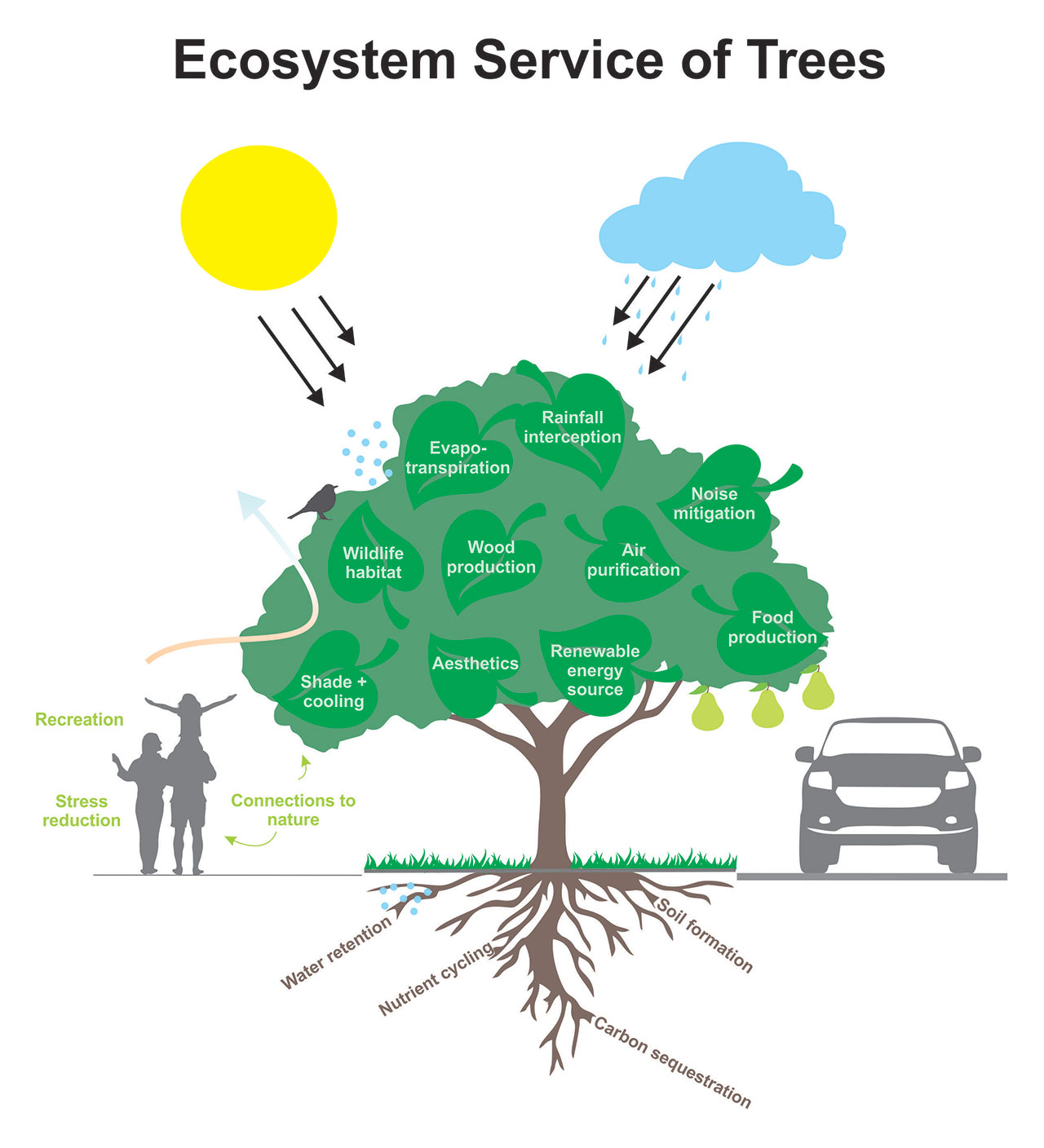
Ecosystem services provided by trees in cities
Source: IEEP UJEP based on Diamond Head Consulting, graphics: AVIgrafik, s.r.o.

Below we present some of the important elements of urban green and blue infrastructure and their most important benefits. Or watch the animated video (after reading the QR code or at http://bidelin.ioer.eu/video), where you will see these elements in the form of characters themselves.
Among the most important elements of urban greenery are parks, which serve the residents and visitors as a space for recreation, meetings and sports activities. According to our research, most people in the park feel relaxed, relaxed and in a better physical condition. International studies have shown that regular residence in urban greenery reduces the morbidity of the population, in particular it improves mental health and self-assessment of the health of city dwellers. However, parks in city centers are also very important in terms of cooling the urban environment. Thanks to the shade and evaporation of water by trees, the air temperature in the park is significantly lower than in the surrounding streets (eg the small-leaved linden cools up to 3.5 ° C due to evaporation).
Another important element of urban greenery are trees, alleys and suburban forests. Trees help cool overheated city centers and provide shade on hot days. In addition, they are very important for improving air quality. One grown tree can capture up to 1.1 kg of dust particles from the atmosphere per year. Trees can also very effectively reduce noise. In suburban forests we have the possibility of collecting mushrooms and forest crops. In addition, they have the ability to absorb and bind greenhouse gases and regulate the water regime in the landscape (a mature tree absorbs up to 300-500 liters of water in a single rain). Suburban forests and forest parks also play an important role in maintaining species diversity. The location of properties near suburban forests and other greenery also has a positive impact on property prices.
Further benefits provided are illustrated in the figure "Ecosystem services provided by urban trees".Urban gardens (so they gardening colonies, community gardens, front yards in housing estates or private gardens) contribute significantly to enhancing the aesthetic function of the area and offer space for recreation, relaxation and active gardening. It is possible to grow and harvest fruits and vegetables, usually in "organic quality". Owing to the possibility of self-supply from our own production, it is possible to reduce the number of deliveries of fruits and vegetables to cities, thereby reducing emissions of harmful substances from automobile transport.
Rivers and reservoirs play an irreplaceable role in urban nature. Their surroundings is a very attractive place for spending leisure time. Evaporation makes it much more pleasant by the water in summer than in the city center. A number of animals and plants are also bound to aquatic ecosystems. It is also often an important source of drinking or service water for the city.
Parking can also be an important green area for the city. Parking areas with permeable surfaces (e.g. grass tiles, etc.) can help reduce flood damage and regulate rainfall. The permeation rate for permeable car parks ranges from 57% to 80% of the annual rainfall, depending on the type of soil / subsoil and the type of permeable surface. The opposite is the asphalted parking lot, which in the summer months often heats up to high temperatures (up to 50 degrees in direct sunlight). Moreover, its surface continues to radiate long after sunset, making a major contribution to the creation of the city's thermal islands.
Mapping of ecosystem services provided in the city of Děčín
In the years 2017 - 2019, habitat types and ecosystem services were mapped on the territory of the city. The results for selected ecosystem services are shown in the figure “Provision of selected ecosystem services depending on the landscape type in Děčín”, where it is possible to see differences in the intensity of provision of these services.
The picture in the middle shows evapotranspiration in the city. It is a physical process in which the liquid state of water is converted into water vapor. Because some of the energy from solar radiation is consumed for this transformation, the surrounding environment cools down during evapotranspiration. In the case of oxygen production (figure at right), this is a secondary process of photosynthesis.
Source: IEEP UJEP a CzechGlobe
At comparing individual maps, it is clear which types of territories provide the most of these ecosystem services. These are mainly continuous foliage, such as forests or city parks. In contrast, densely built-up areas provide very few of these ecosystem services.
Importance of ecosystem services concept for city planning and development
The ecosystem services in the city are often taken for granted and are not really perceived by the society until they are stagnated or missing. The benefits of urban nature are rarely given real value in urban planning.
When was decided that building growth of a city and defining other building plots, it is necessary to take into account which areas provide sufficient ecosystem services and in which it is necessary to leave sufficient space for urban nature or to create this space for further growth. An important aspect of planning the construction activity is also the interconnection of individual areas of urban greenery. Modern green roofs and house facades, for example, offer the potential for further development. They bring a wide range of benefits both to the property owner himself (eg reducing the cost of insulating the roof) and to the company (e.g. aesthetic function, cooling the environment).
The value of the benefits that urban nature brings us is not easy to express. With the concept of ecosystem services, however, it is possible to map these benefits both in biophysical units (e.g. the amount of pollutants captured from the air, the amount of captured water, etc.), and often in financial units. This information can then help to incorporate the value of nature into decision-making processes and thus make it more visible.
This section serves advanced users who want to be able to download the offered routes to their devices - smartwatches, navigations, mobiles and more.

- Naučná stezka Pastýřská stěna ve formátu GPX
- Bežecké trasy ve formátu GPX
- Cyklotrasy ve formátu GPX
- Nordic Walking ve formátu GPX
![]()
Na vrcholu stolové hory Kvádrberk jsou vyznačené čtyři běžecké trasy různé obtížnosti. Trasy vedou příjemným, stinným terénem, přičemž každá z nich má své barevné označení.
Začátek všech tras začíná u dřevěné lavičky „Milenecké hlavy“, ke které se člověk dostane zdoláním několika desítek kamenných schodů. Ty se táhnou až na vrchol stolové hory. U lavičky se nachází mapa běžeckých okruhů.
Běžecké okruhy jsou vhodné pro osoby všech věkových kategorií a je možné je využít i pro jiné sporty, jako je například nordic walking, nebo běh se psy. Od března do října zde každé pondělí probíhají měřené tréninky pro skupiny i pro nově příchozí. Tyto tréninky zajišťuje spolek Konkordia Děčín.
Okruhy: Nejkratší, bílý okruh se jmenuje Vodárna a je dlouhý 750 metrů, následuje červený okruh Obůrka - 1 450 metrů, modrý okruh Trojka - 2 410 metrů a nejdelší žlutý se nazývá Vyhlídky a měří 2 750 metrů. Na vyznačené mapě jsou uvedeny vzdálenosti mezi jednotlivými křižovatkami, každý běžec si tak může zkombinovat jakoukoliv trasu a spočítat celkovou délku svého běhu.
Trasy vznikly ve spolupráci města Děčín a spolku Konkordie Děčín.
Naučnou stezkou k vyhlídce Kvádrberk
Po červené turistické značce, která začíná u děčínské nemocnice, dojdete bukovým lesem po klikaté stezce na vyhlídku Kvádrberk. Velkolepý pohled na střechy města si rozhodně nemůžete nechat ujít, ale je to jen začátek výletu a tedy první vyhlídka. Po červené se vydejte dál po hřebeni pískovcové hory, lemující Labské údolí. Zhruba po kilometru dojdete k další vyhlídce s názvem Labská stráž. Malý pískovcový pavilonek skýtá úchvatný pohled na hluboké údolí a Labe razící si cestu pískovcovými hřebeny. Cesta se tu stáčí pomalu doprava a pomalu se odklání z Labského kaňonu. Zde se můžete rozhodnout, zda se lesní pěšinou vrátíte do lesoparku nebo zda bude pokračovat. Kratší varianta je cca 3 km dlouhá. Pokud se rozhodnete pokračovat, musíte počítat s tím, že nachodíte 12 km. Odměnou vám budou výhledy na kaňon Labe, který je největším pískovcovým kaňonem v Evropě. Vydejte se tedy směrem k Loubskému potoku abyste se brzy opět vrátili k hřebenům skal směrem na Růžový hřeben. Z nezapomenutelného pohledu na Růžový hřeben se můžete vrátit stejnou cestou po červené, nebo na rozcestí Nad Loubím odbočit po zelené tmavou roklí do Loubí. Zelená značka vede příjemnou cestou obklopenou skalními masivy a stejně jako červená končí v Děčíně, s tím rozdílem, že vás zavede do dolní části lesoparku, kde se nachází dětské hřiště a naučná stezka. Nejnáročnější turisté mohou po červené dojít až do Hřenska. Na trase potkají skalní vyhlídku Belveder, kde je možné se občerstvit. Cesta z Děčína do Hřenska je dlouhá 17 km.
Hned několik lákadel najdete v lesoparku na Pastýřské stěně. Přímo v centru města si užijete výlet po hřebenech pískovcových skal, který lze spojit s návštěvou Zoo nebo vyhlídkové restaurace. Výlet je možné začít na Labském nábřeží nebo na Pastýřské stěně. Pokud vyjedete autem až na parkoviště ZOO vydejte se po cestě směrem k výletní restauraci. Ti zdatnější si jistě užijí delší variantu, vedoucí po červené turistické značce z Labského nábřeží, kamennou pěšinou k vrcholu stěny. Na vrcholu vás čeká kouzelný pohled na Labské údolí, zámek a město. Odsud pokračujte stále po červené značce po hřebenech skal, otevírat se před vámi budou rozmanité výhledy na okolní přírodu a město. Stezka vás zhruba zavede na skalní výstupek s výhledem. Na tomto místě se cesty oddělují, červená turistická cesta vás dále povede cca 9 km až na Sněžník, neznačená, ale udržovaná cesta městského lesoparku vás provede skalními pěšinami kolem palouku s dětským hřištěm zpět k zoologické zahradě. A i tady si můžete vybrat jednu ze tří zpátečních cest. Vrátit se můžete k výletní restauraci a pokračovat cestou k Labskému nábřeží, nebo můžete využít další z pěšin po pískovcových skalách Pastýřské stěny a užít si pohledy na řeku a zámek. Poslední z cest vede po příjezdové cestě na Teplickou ulici. Celý okruh je nenáročná vycházka zhruba 3 km dlouhá lemovaná odpočívadly s krásnými výhledy, vhodná i pro rodiny s dětmi.
V lesoparku na Pastýřské stěně jsou vyznačeny čtyři základní okruhy. Každý z nich je odlišen barvou a město počítá s tím, že je v budoucnu ještě rozšíří. „V tuto chvíli máme vyznačeno zhruba 17 km. Trasy jsou koncipované jako čtyři okruhy a obsáhnou prakticky celou vrchní část lesoparku. Barevně vyznačené cesty lze chodit oboustranně,“ řekla Hana Cermonová, náměstkyně primátorky. Na trasy upozorní tabule umístěné na odstavném parkovišti u kruhového objezdu, před hlavním nádražím, na parkovišti u zoologické zahrady a přímo v lesoparku.
ČERVENÁ TRASA
Délka trasy: 5km
Výchozí bod všech nordic walkingových tras je za viaduktem na ulici Čsl. mládeže. Kamenitá cesta vede vzhůru na Pastýřskou stěnu příjemnými serpentinami směřujícími na rozcestí. Zde se trasa točí doprava podél výstupu via ferraty až k restauraci s vyhlídkovou věží. Místo nabízí úchvatné výhledy na děčínský zámek a řeku Labe. Pokračujte po červeně značené trase vedoucí lesem nad zoologickou zahradou. Zhruba v polovině se před vámi otevře výhled na nejvyšší stolovou horu v České republice, Děčínský Sněžník. Příjemná kamenitá cesta vás nyní povede dolů směrem na palouk s dětským hřištěm a dále pokračuje k zoologické zahradě a k restauraci Pastýřská stěna. Závěr trasy vede po stejné cestě, tedy po kamenných serpentinách až k výchozímu bodu.
ZELENÁ TRASA
Délka trasy: 4km
Z ulice Čsl. mládeže se vydáte vzhůru po kamenité cestě k Jahnově vyhlídce, prvnímu rozhledovému místu trasy. Z vyhlídky pokračujete po lesní cestě k velmi málo frekventované asfaltové silnici směrem k zoologické zahradě a dále lesní pěšinou na palouk s dětským hřištěm. Postupujte po kamenné cestě k Bělské vyhlídce a po hřebeni k rozcestí u staré vodárny. Půjdete nad zoologickou zahradou až k vyhlídkové restauraci Pastýřská stěna. Navštívit zde můžete rozhlednu ve věži a vydat se po kraji masivu nad výstupovými cestami ferraty až k rozcestí u Jahnovy vyhlídky a dále po cestě zpět dolů k viaduktu.
MODRÁ TRASA
Délka trasy: 4km
Trasa začíná za viaduktem v ulici Čsl. mládeže výstupem po kamenité cestě k rozcestí a k Jahnově vyhlídce. Odtud pokračujte po lesní cestě k málo frekventované asfaltové silnici a po ní k vyhlídkové Restauraci Pastýřská stěna. Monumentální výhledy na děčínský zámek, řeku a začínající Labský kaňon stojí za chvilku zdržení. Trasa dále vede nad zoologickou zahradou a přes několik rozcestí se směřuje k Bělské vyhlídce. Nyní jste zhruba v polovině a můžete si v dálce prohlédnout nejvyšší stolovou horu Děčínský Sněžník (723 m). Cesta dále vede po hřebeni stěny a pomalu vás vrací zpět k vyhlídkové restauraci. Pokračujete pěšinou podél výstupu via ferrat, minete rozcestí u Jahnovy vyhlídky a dojdete zpět k výchozímu bodu.
ŽLUTÁ TRASA
Délka trasy: 4km
Žlutá trasa opět vychází od viaduktu na ulici Čsl. mládeže a klikatí se kamennou stezkou vzhůru po Pastýřské stěně k Jahnově vyhlídce plošina a pokračuje po malé asfaltové silničce vlevo k zoologické zahradě. Trasa na parkovišti před zahradou vede na lesní cestu a po čase se prudce stáčí vpravo šikmo vzhůru nad zoologickou zahradu na turistické odpočívadlo. Cesta se dále vine ke staré vodárně a pokračuje krátce po hřebeni stěny. Tato klikatá trasa vás povede podél zahrady zpět na silnici a poté k vyhlídce pod Restaurací Pastýřská stěna. Také zde se můžete rozhlédnout a vychutnat si velkolepý výhled na zámek a jeho okolí. Cesta zpět dále pokračuje podél výstupních tras ferrat, po klikaté kamenné pěšině k výchozímu bodu.
Nordic walking pochází s Finska a je v poslední době velmi vyhledávaným sportem. Při dynamické chůzi s holemi totiž dochází k zapojování svalů také trupů a paží, a tím pádem ke komplexnímu zapojení celého těla. Tato pohybová aktivita je vhodná pro téměř všechny věkové i výkonností skupiny. Výborný je pro rekonvalescenty, maminky po porodu nebo seniory.

